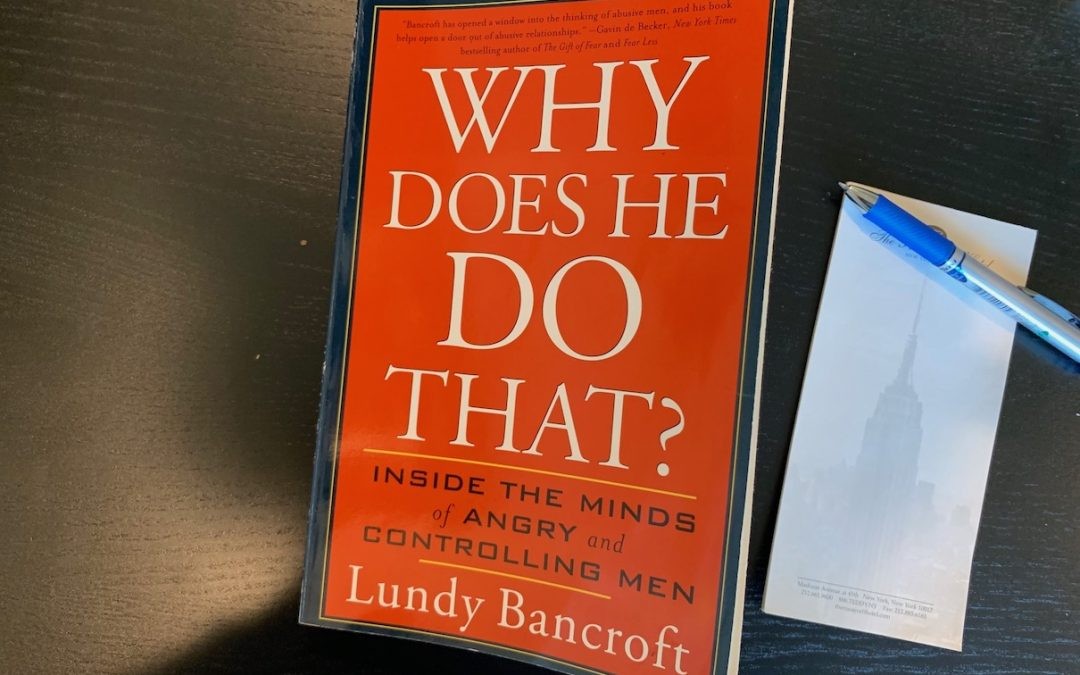 Book cover of 'Why Does He Do That?' by Lundy Bancroft, a popular book on domestic violence, critiqued in this review for its approach and research basis.
Book cover of 'Why Does He Do That?' by Lundy Bancroft, a popular book on domestic violence, critiqued in this review for its approach and research basis.
I frequently receive inquiries about Lundy Bancroft’s widely recognized book, Why Does He Do That? Despite its status as a best-selling book in the realm of domestic violence, it’s notably absent from our list of recommended readings. This often prompts questions from those curious about our rationale, and sometimes, assertions from others who believe we are overlooking crucial insights into abuse and those who perpetrate it.
This omission is intentional. The reason Why Does He Do That? is not suggested for individuals seeking to change their harmful behaviors stems from our assessment that it is, at best, unhelpful. Despite its promising title, the book fundamentally misunderstands the core motivations driving most harmful actions. More concerningly, it can inadvertently leave individuals striving for positive change feeling unnecessarily confused, ashamed, and without hope.
Is It Fair to Question This Book’s Approach?
You might be questioning how we can assert the book is misguided. Bancroft is presented as a seasoned counselor with extensive experience working with men who abuse, spanning over a decade. The book’s immense popularity would seem to indicate its value and credibility. How can we claim it “badly misses” the underlying causes of abuse?
The answer lies in research. Not just anecdotal evidence, but the rigorous findings from numerous social scientists who employ meticulous methodologies to study this complex issue and uncover evidence-based answers. We aren’t referring to a single study from a researcher with potential biases, but rather, the consistent conclusions drawn from hundreds of diverse investigations.
Perhaps the clearest way to illustrate our perspective is to directly compare Bancroft’s assertions with the established findings of research. Below, we outline key points from Why Does He Do That? alongside what objective, evidence-based research has revealed.
Decoding ‘Why Does He Do That?’: Bancroft’s Perspective
Defining the Perpetrators of Abuse
The title, Why Does He Do That?, immediately establishes Bancroft’s perspective: in heterosexual relationships, men are overwhelmingly the perpetrators, and women are the victims. In his extensive 400-plus page book, he dedicates minimal space—just two paragraphs—to acknowledge the possibility of women abusing men. When he briefly considers whether physical aggression from women towards men constitutes abuse, he equivocates with, “It depends.” He quickly dismisses this notion, arguing that men are rarely significantly impacted by female aggression.
Bancroft’s Theory on the Motivation Behind Abuse
Bancroft posits that abuse is a calculated and deliberate choice. He argues that abusive men engage in this behavior purposefully because it serves their interests. By mistreating their partners, abusers allegedly gain dominance and control, making it easier to release negative emotions and compel their partners to fulfill their demands—whether physical, emotional, or sexual.
According to Bancroft, abusers harbor feelings of superiority, are intensely self-centered, and display intolerance towards any form of defiance. They are driven by a relentless pursuit of power and social status, aiming to control every aspect of their environment and relationships through any means necessary. Often, they are portrayed as charming manipulators, skilled at concealing their controlling nature and deceptive tactics.
He emphasizes that the core issue isn’t a lack of awareness of the harm they inflict. Instead, Bancroft argues that abusers simply do not value their victim’s well-being or happiness. Furthermore, these men are depicted as comfortable resorting to violence, intimidation, and emotional manipulation to achieve their goals. Why Does He Do That? asserts that this behavior is learned—from family dynamics, media portrayals, and societal norms that endorse male dominance.
Limited Hope for Change
Bancroft expresses skepticism about the potential for abusers to change. He suggests that genuine change is infrequent because abusers are unwilling to relinquish the perceived privileges they gain through control and abuse. Due to this low intrinsic motivation, Bancroft argues that significant external pressures are necessary to instigate change, such as the threat of losing their partner or facing severe legal consequences. He believes that lasting change is primarily driven by imposing consequences for abusive behavior, educating about his defined causes of abuse, and directly confronting the abuser’s “wrong-headed” attitudes.
In the appendices of Why Does He Do That?, Bancroft outlines a rigorous set of steps he deems necessary for a man to demonstrate genuine change. These steps include, among others, unequivocally acknowledging that he chose to be abusive, admitting to a deep-seated sense of entitlement, accepting any and all consequences his partner deems appropriate, and surrendering any right to complain about his treatment.
The Research Perspective: Evidence-Based Findings
What does systematic research reveal? Most of us don’t have the inclination or time to sift through extensive academic research. Fortunately, experts have already undertaken this task. A team of researchers conducted a comprehensive meta-analysis, examining over 12,000 studies related to domestic violence and abuse. Their findings are compiled in a 2,657-page database, which includes summaries of 1,700 peer-reviewed studies. These researchers provide transparent access to their source studies for anyone wishing to verify their conclusions.
Their findings are accessible on the website of the Association of Domestic Intervention Providers (ADVIP) and were published in the peer-reviewed journal, Partner Abuse. For broader accessibility, the researchers synthesized their extensive analysis into a report titled, The Partner Abuse State of Knowledge Project. Their concise Findings-At-a-Glance report serves as the primary source for the research data presented here and underpins all programs at the Ananias Foundation.
Research-Based Profile of Perpetrators
Research indicates a broader scope of perpetration than Bancroft suggests. Overall, 25.3% of individuals report perpetrating intimate partner violence (IPV) at some point in their lives. Interestingly, studies reveal that rates of female-perpetrated violence are actually higher than male-perpetrated violence (28.3% vs. 21.6%) when averaged across multiple studies. Regarding emotional abuse, a staggering 80% of people admit to engaging in either expressive abuse (name-calling, insults) or coercive control (controlling behaviors). Specifically, 40% of women and 32% of men reported using expressive abuse, while 41% of women and 43% of men admitted to using coercive abuse.
Within relationships characterized by abuse, large-scale population studies indicate that 57.9% of IPV is bi-directional, meaning it occurs mutually. Of the remaining 42% of uni-directional violence, 13.8% is male violence against females, and a notable 28.3% is female violence against males. This data often surprises people, as it sharply contrasts with the dominant narrative surrounding domestic violence.
Regarding the impact of abuse, research confirms that female abuse victims experience significant adverse effects, including more injuries, mental health challenges, and substance abuse issues compared to non-victimized women. Their self-esteem, professional lives, and social interactions are also negatively affected—findings that are consistent with common understanding.
Research focusing specifically on male victims is less extensive. Existing studies present mixed results; some indicate that male victims experience comparable levels of distress and negative impacts as female victims, while others do not. While more research is needed to draw definitive conclusions about male victims, it is irresponsible to assume that men are unaffected by abuse.
Motivations for Abusive Behavior: Research Insights
Research contradicts Bancroft’s assertion that abuse is primarily motivated by a desire for power and control. Studies reveal that both men and women perpetrate violence for similar reasons. The most frequently cited motivation is retaliation—to “get back” at a partner for causing emotional pain. Other significant factors include stress, jealousy, expressing anger or other difficult emotions, and seeking a partner’s attention.
Childhood experiences also play a crucial role. Individuals who experienced abuse as children are more likely to perpetrate domestic violence in adulthood. Dysfunctional mother-child relationships during toddler years and poor father-child relationships during school-age years have particularly strong correlations with later abusive behavior. Life experiences and emotional trauma, especially in childhood, appear to significantly predispose individuals to act harmfully in their adult relationships.
Prospects for Change: What Research Suggests
Research offers a more nuanced view on the potential for change and the effectiveness of interventions. Data on perpetrator intervention programs show mixed results. The most positive outcomes are associated with interventions that prioritize building strong therapist-client relationships, emphasizing the importance of empathy, respect, and positive engagement.
Notably, research has not identified any single type of intervention program as definitively superior to others. This suggests that a mandated, rigid theoretical or ideological approach to treatment is unwarranted. The field is still evolving in understanding what methods are most effective in facilitating positive change.
Furthermore, research casts doubt on the effectiveness of law enforcement and the criminal justice system as primary solutions for domestic violence. Analysis indicates that legal sanctions following an arrest do not demonstrably reduce the likelihood of re-offense. However, research does highlight a disparity in the justice system, showing consistent evidence that men are treated more harshly than women at every stage of prosecution.
Seeking Truth: Bancroft vs. Research
As is evident, Lundy Bancroft’s book Why Does He Do That? and the body of empirical research reach significantly different conclusions regarding numerous aspects of domestic violence. How do we discern which perspective is more accurate—Bancroft’s or the research-backed view? The answer lies in the fundamental principles of knowledge acquisition: we rely on sound, validated methodologies to test claims and then place our trust in the findings derived from those methods.
‘Why Did He Write That?’ Exploring Bancroft’s Motivations
Personal biases and underlying motivations likely influenced Lundy Bancroft’s objectivity in writing Why Does He Do That? He did not conduct formal research for his book. Instead, his work is reportedly based on his observations of men in group sessions at Emerge, a batterer intervention program provider in Massachusetts.
Emerge holds the distinction of being the first agency in the U.S. to offer such services. While “first in the nation” sounds impressive, it also means the program was developed based on an ideology that lacked robust empirical validation.
Emerge adopted, and continues to utilize, the feminist model of domestic violence as the foundation of their programs. This theoretical framework posits that domestic violence is primarily perpetrated by men fitting the profile described in Why Does He Do That? The motivations attributed to abusers in this model align directly with Bancroft’s assertions: a sense of superiority and a drive for power and control.
It is therefore not surprising that Bancroft’s observations at Emerge seemed to confirm the very traits and motivations that his training had predisposed him to expect. This phenomenon is known as confirmation bias—a significant pitfall when drawing conclusions from personal experiences. Even when faced with contradictory evidence, Bancroft appears to have prioritized the prevailing theory over the accounts and experiences of the individuals he was working with.
For instance, Bancroft mentions the common explanations offered by men in his groups for their abusive behaviors. They often cited a lack of understanding of their actions, an inability to control their emotions, or the influence of unresolved trauma or substance abuse. However, Bancroft summarily dismissed these explanations as mere attempts to deflect responsibility, rather than considering them as potentially valid insights.
Writing for a Specific Audience
It’s also crucial to consider Lundy Bancroft’s intended audience for Why Does He Do That? In his own words, it is primarily aimed at female partners of abusive men. It is decidedly not designed as a self-help resource for individuals who have engaged in harmful behavior.
His stated objective is to persuade women to leave abusive relationships. To achieve this, the most effective approach is to portray the abuser as a fundamentally flawed, self-absorbed narcissist who is incapable of genuine love or care. Presenting the abuser as a “wounded soul” acting out due to past traumas might evoke empathy and foster hope for change—outcomes that would likely undermine Bancroft’s goal of encouraging women to leave. By painting a bleak picture of the abuser’s potential for change, Bancroft reinforces the message that leaving is the only viable option.
As an author myself, I have gained insights into the dynamics of book success. One reliable strategy is to “write to market”—creating content that aligns with the known desires and expectations of a specific readership. If vampire novels are popular, writing a vampire novel increases chances of success.
Similarly, domestic violence advocates have long expressed frustration over why many abused women remain in harmful relationships. Furthermore, the feminist model of abuse is widely embraced within domestic violence organizations. Framing domestic violence as a battle against a villainous abuser serves to galvanize members and facilitate fundraising efforts.
Whether through calculated marketing strategy or sheer luck, Why Does He Do That? provided these advocates and organizations with a seemingly “authoritative” tool to reinforce their pre-existing messages. This approach is highly effective in securing endorsements and recommendations from influential figures within the field. Prioritizing alignment with prevailing narratives over empirical accuracy can be a powerful, albeit ethically questionable, path to widespread book adoption and authorial success. It also established a lucrative platform for Bancroft to generate income through speaking engagements, training workshops, and expert witness testimonies.
Personal Experience and Contrasting Perspectives
While anecdotal, and therefore not scientifically rigorous, my personal experience offers a contrasting perspective. When I was grappling with understanding my own hurtful and abusive behaviors, Bancroft’s descriptions did not resonate with my internal experience. I was not consciously trying to be abusive, did not decide to abuse, and had no desire for power or control over my partner.
While charm might not be my defining characteristic, I genuinely loved my wife and felt profound distress at the realization that I was causing her pain. Consistent with research findings, my actions were often driven by a desire to stop what I perceived as her hurtful words and actions towards me.
In my subsequent seven years working with individuals who have caused harm in their relationships, I rarely encounter the denial or attitudes characterized in Why Does He Do That? More frequently, our clients are contrite, humble, and deeply regretful individuals who express profound remorse for the impact of their behaviors and a strong motivation to change, if they can find a constructive path forward.
As they explore their personal histories, they often share stories of adverse childhood experiences and begin to connect their past traumas to their present hurtful behaviors. They have, indeed, perpetrated abuse, but often, they were also victims themselves. The adage, “hurt people hurt people,” resonates deeply in their narratives.
The Detrimental Impact of Why Does He Do That?
It is deeply concerning that Why Does He Do That? has gained such widespread acceptance within the domestic violence community. The confusion, shame, and hopelessness it can engender have caused significant and unnecessary harm to many readers. Only by embracing a more complex and truthful understanding of domestic violence—as messy and uncomfortable as it may be—can we hope to effectively address and ultimately reduce its occurrence.

